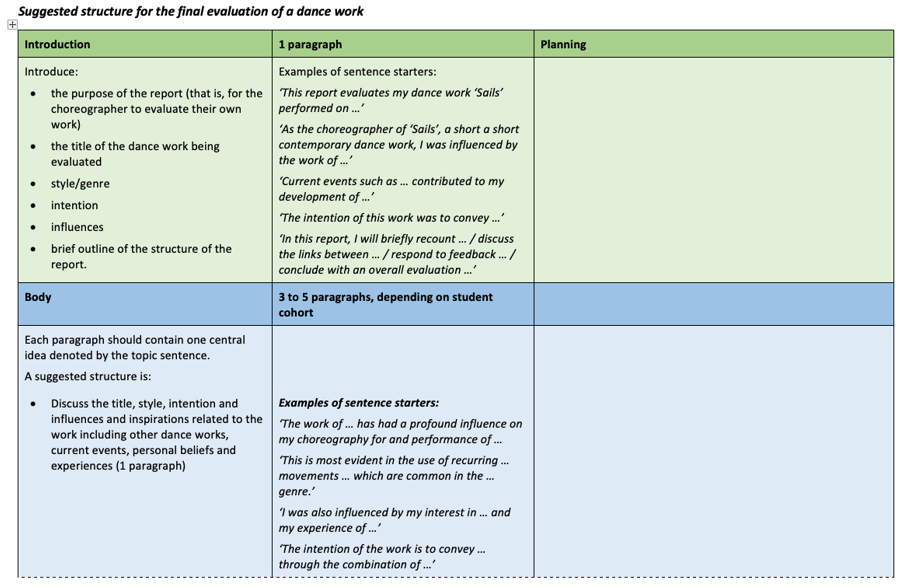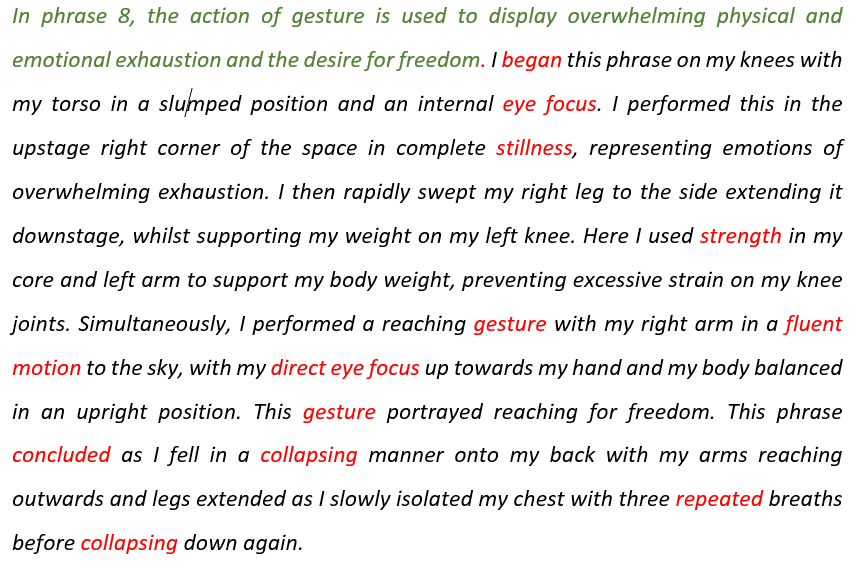Written self-evaluation
In Dance, students must evaluate their own dance works. This is part of the Choreographic Process
(ISARE), which includes:
Improvisation
Selection
Arrangement
Refinement
Evaluation.
During each stage of the process, students will draw on a range of literacy strategies including:
- developing and using dance-specific terminology
- connecting verbal language and movement
- exploring and expressing ideas using stimulus material
- interpreting, analysing, planning, and producing oral, written, and multimodal texts
- communicating with their peers
- articulating their intention and influences
- giving and responding to feedback.
In practice
The following approach focuses on the final evaluation of the dance work in a written report.
- The teacher provides the students with the following
template that provides a suggested structure for the evaluation and is intended as a planning resource for students.

- The teacher leads a discussion of the template document including highlighting the following:
- The suggested structure of the evaluation report
- The sentence starter examples
- The use of tense (for example, use of past tense when recounting the performance)
- The use of verbs to indicate dance movement and communication of intention (for example 'conveyed').
- The teacher provides examples of the ways in which noun groups may provide detailed information, for example, 'a reaching gesture', 'a forceful kick'.
- The teacher asks the students to write and share examples of their own noun groups in describing their own works. These are noted in the 'Planning' column of the template.
- The teacher discusses the use of adverbs and prepositional phrases (When? Where? How? In what manner?) that provide vivid details of actions and movements, for example: 'on my knees'; ' with my torso in a slumped position'; ' in the upstage right corner of the space'; ' in a fluent motion to the sky'.
- Students are asked to formulate and share their own prepositional phrases based on their own dance works. These are noted in the 'Planning' column of the template.
- The teacher and students draw on the earlier activities to read and
deconstruct the following sample paragraph identifying the following:
- Topic sentence
- Use of first person 'I'
- Intention
- Elaborations or examples linked to the intention
- Dance-specific vocabulary
- Varied verbs
- Noun groups
- Adjectives
- Adverbs
- Prepositional phrases
- Linking words/connectives to create cohesion.
In phrase 8, the action of gesture is used to display overwhelming physical and emotional

- Teacher asks students which resources they may draw on to aid in the planning and writing of their reports, for example:
- Dance glossaries and word banks
- Graphic organisers
- Dance journals
- Sample paragraphs
- Planning template (see above)
- Students are given time to begin completing their planning template drawing on the resources above.
- At regular intervals, the teacher monitors and offers feedback and advice through one-on-one scaffolding and whole class discussions.
Curriculum links for the above writing piece:
VCADAP037,
VCADAR038,
VCADAR039,
VCADAR045,
VCADAR046.
Learning sequence
The learning sequence for Levels 7 and 8 in Dance, demonstrates how literacy teaching strategies can be used in a sequence.
A
learning sequence tool is also available to assist in the planning of Dance and Literacy across a series of lessons.